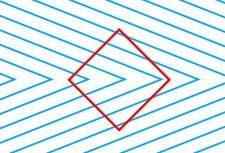Orbison illusion
An Orbison illusion is an optical illusion where straight lines appear distorted. There are several variants of the Orbison illusion. The illusion is similar to both the Hering and Wundt illusions. Although the Orbison illusion and other similar illusions have not been completely explained, they has stimulated much valuable research into human perceptual processes. They have also been utilized by artists to bring about entertaining and impressive effects in their works.
Discovery
The Orbison illusion is named for psychologist William Orbison, who first published his findings in a 1939 issue of the American Journal of Psychology. In addition to the figures that have taken his name, Orbison also included figures such as the Hering and Wundt illusions in his article, which discussed the potential cause of these sorts of illusions.
Description
The Orbison figures most often involve a figure placed over a background of concentric circles or radial lines. The figure appears distorted because of the background image; squares appear to bulge and circles often appear elliptical.
Explanation
Orbison explained these illusions with the theory that fields of force were created in the perception of the background patterns. Any line that intersected these fields would be subsequently distorted in a predictable way. This theory, in the eyes of modern science, does not have much validity.[1]
It is still unclear exactly what causes the figures to appear distorted. Theories involving the processing of angles by the brain have been suggested. Interactions between the neurons in the visual system may cause the perception of a distorted figure.[2] Other theories suggest that the background gives an impression of perspective. As a result, the brain sees the shape of the figure as distorted.
Applications
Like similar perceptual illusions, the Orbison illusions help researchers better understand how the brain and visual systems process information. It also provides an intriguing experience for viewers, and as such has been utilized by artists in their works.
Notes
- ↑ James Outram Robinson, The Psychology of Visual Illusion (Mineola, NY: Dover Publications 1998). ISBN 0486404498
- ↑ Sara Bolouki and Roger Grosse, Honglak Lee, and Andrew Ng. 2007. Optical Illusion. Standford University. Retrieved November 21, 2007.
ReferencesISBN links support NWE through referral fees
- Fineman, Mark. The Nature of Visual Illusion. Dover Publications, 1996. ISBN 0486291057
- Gregory, Richard L. Eye and Brain. Princeton University Press, 1997. ISBN 0691048371
- Robinson, J.O. The Psychology of Visual Illusion. Mineola, NY: Dover Publications, 1998. ISBN 978-0486404493
- Seckel, Al. The Art of Optical Illusions. London: Carlton Books, 2000. ISBN 1842220543
- Shepard, Roger N. Mind Sights: Original Visual Illusions, Ambiguities, and Other Anomalies, With a Commentary on the Play of Mind in Perception and Art. New York: W.H. Freeman and Company, 1990. ISBN 978-0716721338
- Wolfe, Alan. The Mind's Eye: Readings from Scientific American. New York: W.H. Freeman and Company, 1986. ISBN 978-0716717546
External links
All links retrieved November 17, 2022.
Credits
New World Encyclopedia writers and editors rewrote and completed the Wikipedia article in accordance with New World Encyclopedia standards. This article abides by terms of the Creative Commons CC-by-sa 3.0 License (CC-by-sa), which may be used and disseminated with proper attribution. Credit is due under the terms of this license that can reference both the New World Encyclopedia contributors and the selfless volunteer contributors of the Wikimedia Foundation. To cite this article click here for a list of acceptable citing formats.The history of earlier contributions by wikipedians is accessible to researchers here:
The history of this article since it was imported to New World Encyclopedia:
Note: Some restrictions may apply to use of individual images which are separately licensed.
